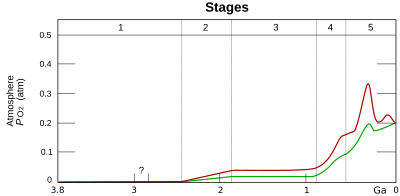Oxygenium (period)
The Oxygenium is the first period within the eon Proterozoikum . It opens the era of the Paleoproterozoic . It follows the period of the siderium and is in turn replaced by the period of the jatulium (or eukaryium ). The oxygenium lasted 170 million years and fills the period from 2420 to 2250 million years BP .
etymology
The name Oxygenium is derived from the Greek ὀξύς ( oxys ) - sharp, pointed, sour and γεννάω ( gen- ) - to generate, to give birth , together thus to generate acid . It alludes to the global increase in oxygen concentrations in the earth's atmosphere during this period .
Redefinition of the Precambrian Periods
In the course of moving away from period boundaries determined purely by radiometry, the GSSP principle should now be applied as far as possible in the Precambrian, according to Gradstein et al. (2012) . The periods are thus defined on the basis of significant geological events and no longer on arbitrary, radiometric ages.
Definition of oxygenium
The lower limit of oxygenium is set by a GSSP at the base of the Kazput Formation in Western Australia . The Kazput Formation, which was deposited around 2,420 million years ago BP, belongs to the Turee Creek Group and thus to the Mount Bruce Supergroup . It carries the world's first glacial sediments . The upper limit of the oxygenium also marks a GSSP. This is at the base of the Canadian Lorrain formation , which belongs to the Cobalt Group of the Huronian Supergroup . The Lorrain Formation, deposited around 2,250 million years ago, marks the end of the glaciation.
The oxygenium thus takes the place of the previous periods Siderium (2500 to 2300 million years BP) and Rhyacium (2300 to 2050 million years BP).
meaning
The importance of the oxygenium lies in a constant increase in the oxygen content in the earth's atmosphere. This led to the Great Oxygen Disaster , which may have triggered the Paleoproterozoic Glaciation that started around 2,400 million years ago . The end of the glaciation also meant the disappearance of the ribbon ores .
First sealing Schelfkarbonate appear ( engl. Cap carbonates ), characterized by high, positive δ 13 C-values are distinguished and the start of Lomagundi-Jatuli isotopes excursion initiate. Oxidized paleosols and red beds (Engl. Red beds ) occur first.
stratigraphy
Significant sedimentary basins and geological formations
-
Hamersley Basin :
- Hamersley Group in Western Australia - 2715 to about 2400 million years BP
- Mount Bruce Supergroup with glacial Kazput formation
-
Transvaal Basin in South Africa - 2670 to 1900 million years BP
-
Transvaal Supergroup :
- Postmasburg Group with Makganyene Formation - diamictite - between 2,415 and 2,222 million years BP
- Pretoria Group with glacial Upper Timeball Hill Formation and glacial Boshoek Formation - between 2320 and 2184 million years BP
-
Transvaal Supergroup :
- Huronian Supergroup in Eastern Ontario - 2,450 to 2,219 million years BP - with the Lorrain formation of the Cobalt Group
Marine geochemistry
Rouxel et al. (2005) establish a strong increase in the oxygen content of the earth's atmosphere for the period 2400 to 2300 million years BP . At about the same time (around 2300 million years BP) they observe an increase in the δ 56 Fe values in the oceans of up to 3 ‰ compared to the Archean. To this day, the δ 56 Fe values are no longer below - 0.5 ‰, whereas in the Archean they could still drop to - 3.5 ‰. The authors explain this fact with the establishment of oceanic depths from 2300 million years BP and an increase in sulphide precipitation compared to iron oxide precipitation .
Basement cranes
- Northern Borborema Province in northeastern Brazil , Médio Coreaú Domain (MCD): Granja Complex - 2350 to 2270 million years ago. The terran consists of metatexitic orthogneiss of tonalitic and granodioritic composition ( TTG complex ), accompanied by high-grade metamorphic rocks such as kinzigites , charnockites and enderbites .
-
Central Brazilian Shield
- Bacajá Domain : 2359 million years BP
-
Tapajόs Parima Province :
- Uatumã-Anauá Domain : 2354 million years BP
- Tapajόs Domain : 2483 to 2380 million years BP
- Guyana Shield , Central Area: 2350 million years BP
- West Africa Craton , Ivory Coast : 2,312 million years BP
Magmatism
- In the Hebridean Terran of Scotland , the Doelritic Scourie dykes invaded the Lewisian basement between 2418 and 2375 million years ago .
Meteorite crater
The oldest known meteorite crater of Suavjärvi was possibly formed in Karelia around 2,400 million years BP .
Individual evidence
- ^ Felix M. Gradstein et al .: On the Geologic Time Scale . In: Newsletters on Stratigraphy . tape 45/2 , 2012, p. 171-188 .
- ↑ James F. Kasting & Shuehi Ono: Paleoclimates: The First Two Billion Years . 2006.
- ↑ Olivier J. Rouxel et al: Iron Isotope Constraints on the Archaean and Paleoproterozoic Ocean Redox State . In: Science . tape 307 (5712) , 2005, pp. 1088-1091 .
- ↑ Santos, TJS, Fetter, AH, Hackspacher, PC, Schmus, WRV, Nogueira Neto, JA: Neoproterozoic tectonic and magmatic episodes in the NW sector of the Borborema Province, NE Brazil, during assembly of western Gondwana . In: Journal of South American Earth Sciences . tape 25 , 2008, p. 271-284 .
